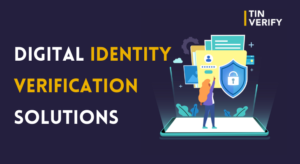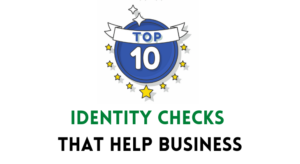Verification is the key to identifying an entity or a person. A legal name or ID is assigned by the federal agencies to denote the existence (or the lack of) of an entity or a person. The majority of our compliance processes require the business ecosystems to obtain these identities from the customer with their consent.
However, it is no surprise that the technologies that the world acquires to move ahead into the future are also the same and if not better technologies that cybercriminals and data compromising organizations use.
It’s true. Our identities are not safe. In fact, someone’s identities are fraudulently used with unauthorized access every 14 seconds. Someone might have lost access to their identities or their federal benefits stolen by the time you finished reading this paragraph.
It’s really that bad.
When our identities are at such a vulnerable state, and when we know that identity verification is really the only way to beat identity fraudsters, the incorporation of a robust identity verification system becomes that much more important.
TINVerify is doing its bit to help enterprise industries counter the risk that comes with identity fraud by providing real-time identity verification solutions (more about this later).
When identity verification is important and its incorporation is so essential, there is nothing wrong in familiarizing yourself with some tips or some hacks, if you will, to leverage the identity verification ecosystem and verify the real identities of entities and persons swiftly.
The following will discuss 10 simple tips that any business can incorporate to optimize their identity verification mechanisms and validate the real identities of a profile successfully.
So, let’s get to it.
Quick Links
- Check the requirements
- Streamline KYC ecosystem
- Obtain the data with adequate proof
- Choose a reliable identity verification infrastructure
- Set up a multi-faceted identity verification process
- Leverage due diligence
- Articulate necessity Vs. scope
- Assess risk prior to onboarding
- Take your time. Don’t be in a rush
- Continue to monitor risk even after onboarding
1.Check the requirements
Identity verification is a comprehensive process that requires the business to obtain a variety of identification data with proof. But to obtain this kind of information, businesses need to have an understanding of their requirements.
The ‘Why’ factor of identity verification.
Why is your business collecting a certain type of identity data? Should your business accept a widely-accepted form of identity as premises for identity or should you ask for more or different information? It all depends on your business process, the nature of your business, your objectives, and the type of customers you plan on onboarding.
Being aware of your requirements and understanding the ground-reality factors that push your business to obtain certain identity data is critical. This is because your identity requirements set the tone for the successive verification processes and the scrutiny of the information makes the prospect plausibly foundational to the identity verification ecosystem.
2. Streamline KYC ecosystem
Before you proceed to obtain the identities of your clients and customers, devise a plan of action for your KYC lifecycle.
Your organization could be working with its existing resources or is planning on onboarding more resources.
If it’s the former, you have to focus on allocating the resources efficiently to ensure that every step of the KYC process is fluid and leads to the successive step of the process, leaving no room for interruption.
If you’re adding more resources, you must figure out a gateway KYC verification system that vets your own resources before they’re allocated to complex compliance departments.
Businesses must understand that the KYC Ecosystem will only run efficiently as long as the internal compliance system also retains compliance. It begins with you.
Streamlining the KYC ecosystem is key to organizing your resources, technologies, and processes. It helps optimize the onboarding or account opening experiences and further helps devise the regulatory KYC policies, preventing risk to a good extent.
3. Obtain the data with adequate proof
When obtaining certain identity data from your customers, consider the proof of identity that you need to obtain to back up the identity claims made by your customers. This, as you progress through the identity verification process, prevents risk.
In simpler terms, when you obtain the proof of identity, such as a copy of the social security card or address proof or other forms of identity proof, these documents act as evidence to back up the identity claims made by the customers.
Let’s say that the social security details provided by the customer are valid, but the identity verification checks, such as TIN Match, show you that the details don’t match the source records (social security administration), which means that the customer either gave you incorrect details or failed to provide valid proof to back up their identity claims – increasing the customer’s risk quotient.
The possibility of risk makes the process of obtaining proof essential.
4. Choose a reliable identity verification infrastructure
Businesses focus on obtaining identities and proof of identity, which is a humongous task on its own. But verifying these identities with an effective and efficient identity verification infrastructure is essential. And when businesses decide on an identity verification system, their teams must consider the key objectives, turnaround time, ease of use, the accuracy of the information, and other critical factors that make the system not just effective but useful for their custom requirements.
If you’re someone who is looking for an effective real-time identity verification system, get started with TINVerify – a federal-authorized identity verification infrastructure that powers your business with real-time identity checks.
The best part about TINVerify, apart from its sleek interface, as-taken-from-source accuracy, and dynamic utility accessibilities, is that TINVerify is highly scalable. This means you can verify millions of profiles within minutes and run your data against a variety of identity checks at once.
Talk to our team to learn more about what TINVerify can enable for your business.
5. Set up a multi-faceted identity verification process
Now, coming back to the identity verification process; many businesses just focus on one aspect of identity while ignoring other plausible outcomes. This could be a problem as it under-utilizes your resources and tools.
Businesses, in a rush to verify the customer profiles, focus on verifying just one or more elements of the identity data and ignore the rest.
For example, when you obtain the social security information of your customers, did you just run the identities against the SSA data list and call it a day? Or did you take the leverage to use the same identities to verify the profile from a different perspective, say, sanction screening?
It’s understandable. Businesses have their targets to meet but compromising the scope of verification reduces your efforts to textbook identity verification, which is not doing much to help your KYC ecosystem. In the long run, this practice can turn out to be redundant.
Setting up a multi-faceted identity verification process, where each profile is verified against a variety of data lists, helps improve the quality of profiles you onboard and ascertains in building a strong customer or user base. And the fact that it helps you prevent risk to a great extent is just a cherry on top.
6. Leverage Due Diligence
Speaking of extending your verification efforts, due diligence helps you assess and prevent risk to a great extent.
Due diligence is the process of screening the identities of your customers with risk-specific data lists. Sanction screening, PEP screening, security compliance screening, OFAC Screening, and more could be seen as examples of due diligence checks.
To a layman, due diligence is a comprehensive investigation of a profile, where a variety of checks are conducted to see if you can find any leads on the profile. These leads are insights that help you analyze and conclude the risk quotient of a profile.
From a business narrative, due diligence enables you to check if a profile is compliant enough to be considered for a potential opportunity or business arrangement.
From a compliance perspective, due diligence helps you assess the risk quotient of a profile.
So, to put it simply, due diligence is just the scrutiny of a profile. And you continue to scrutinize and validate the identities until you arrive at a decision – only this decision is backed up with evidence taken from a series of checks.
7. Articulate Necessity Vs. Scope
While regulatory compliance agencies, such as OFAC, FATF, and more recommend businesses to conduct comprehensive checks prior to onboarding, they also encourage businesses to use their discretion on the scope of the verification conduct.
This means businesses are free to utilize the identity verification ecosystem as needed but within reason and feasibility.
The compliance teams within the organization must be trained on various KYC policies and even encourage moderated interviews with customers to build a foundational relationship with the profile before taking things to the next level. Your personal judgment also plays a role in this aspect.
Businesses must consider that the scope of identity verification and the necessity of identity verification are not mutually inclusive. Every business, within its objective criterion and feasibility, must verify identities but they also need to understand that the scope of scrutiny is not pre-defined or regulated, which leaves the burden (financial and compliance) on the business.
The best way to conclude the scope of scrutiny is to set up certain “lead factors” or checkpoints, which indicate that a profile is most likely to be non-compliant.
By setting up a Risk Threshold, businesses can easily assess the risk and reject all profiles whose risk quotient goes above this threshold. This helps businesses save both time and resources spent on assessing the risk quotient of a profile.
8. Assess risk prior to onboarding
Speaking of risk assessment, federal agencies advise businesses to assess risk prior to onboarding. This is crucial because once a high-risk profile is onboarded, the business could be held liable for the customer’s actions.
Say, a bank has onboarded a high-risk profile by mistake because it failed to assess the risk quotient of a profile. In reality, this customer’s risk quotient exceeds the risk threshold of the bank.
Now, let’s say that the customer is engaged in a high-value transaction that involves a certain individual flagged as a threat by OFAC.
Both the bank and the customer are liable for violating the compliance norms. The customer is liable because of engaging in commercial conduct with a restricted/sanctioned individual. The bank is liable because it compromised the AML regulatory protocols, and therefore is complicit in a questionable transaction.
Many banks in recent times have been penalized for similar AML inconsistencies.
Risk assessment is just that important because it is directly linked with AML compliance. If a financial institution is failing to verify its customers, it’s a part of the problem.
This is why compliance agencies encourage financial institutions and businesses in the BFSI industries to prioritize risk assessment prior to onboarding.
9. Take your time. Don’t be in a rush
An overlooked part of this entire regime is that businesses do not have time. It’s understandable.
And so, businesses are in a rush to verify more profiles as fast as they can, not realizing that this speed could compromise the quality of their user/customer base, and could result in non-compliance complexities in the future.
A business, as ambitious as it may be, must take the time to verify its customers thoroughly. Risk assessment and identity verification alone will help you decide if an entity or an individual is worth the chase.
What’s more? This process could be an opportunity for your business to try out new ways to engage your users while your compliance teams are at work. Many businesses are making use of this space creatively by simplifying the customer onboarding process with unique UX and UI experiences.
Even something as dynamic as TINVerify can be easily scaled to import your customer data as and when the customers are registering with your business. And TINVerify’s super-fast verification processes enable you to verify 100,000+ checks within seconds with real-time accuracy. This means reduced turnaround time and creating a free flow of user experiences.
10. Continue to monitor risk even after onboarding
So, you’ve done everything to onboard a great customer. The deal is done and they’ve paid you. Now what? You will want to onboard more customers and expand your business. And as years roll by, you will wonder if the very first customer you’ve onboarded is still a safe bet. So, you will validate their profile once again.
This is continued risk monitoring.
Now, imagine the amount of risk monitoring a financial institution that observes an influx of customer profiles on a daily, needs to facilitate.
Continued risk monitoring not only enables you to keep your customer records up to date but allows you to screen your customer profiles for elevated risk quotients. Many businesses even plan out their risk screening operations to validate their customer profiles from time to time.
Additionally, continued risk monitoring ascertains in submitting Suspicious Activity Reports (SARs) to law enforcement in extreme cases.
So, there you have it.






